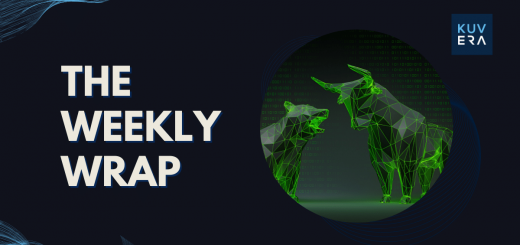In this edition, we talk about economic indicators and the flip-flop in India’s wheat policy. We also talk about an Essar-ArcelorMittal deal and the man who can’t seem to stay out of news these days—Gautam Adani
Welcome to Kuvera’s weekly digest on the most critical developments related to business, finance and markets.
tl;dr Hear the article in brief instead?

Six months ago, on Feb. 24 to be precise, Russia invaded Ukraine. Those who might have predicted that Vladimir Putin’s mighty Russian army would overrun the smaller neighbour within days have been left scratching their heads. The Ukrainian people have shown extraordinary resilience and just this week celebrated their Independence Day.
Why are we talking about a war taking place thousands of miles away? Simply because in this interconnected world, an event in one part of the globe often affects people living in others parts of the planet.
For the purpose of this newsletter, however, we will restrict ourselves to the war’s impact on business, economy and markets. The war has not only dragged the Russian and Ukrainian economies into a recession but also dragged the entire European economy into a crisis. The US, the world’s biggest economy, is also staring at a recession.
What about the Indian economy? Well, the government and the Reserve Bank of India continue to expect gross domestic product to grow above 7% in the current fiscal year. Data for the first quarter, April-June, to be released next week will give some more indications about the state of the economy.
However, high-frequency indicators—which are released monthly, unlike the quarterly GDP data—paint a mixed picture.
Consider this, for instance. Purchasing managers’ surveys, which gauge business activity across the manufacturing and services sectors and measure the prevailing direction of economic trends, show that India’s services activity in July actually fell to the lowest level in four months on weaker sales growth and elevated inflation.
The numbers showed that the biggest impact was on international demand, which worsened. In fact, this was enough to offset gains in the manufacturing sector that grew at the fastest pace in eight months.
Put simply, higher prices are singeing exports. This, in turn, meant India’s trade deficit widened as imports jumped to record levels. For a country that is forever looking to be the next China, this cannot be good news.
But it wasn’t all bad news either. Passenger vehicle sales rose for a second straight month and bank credit continued to grow despite higher interest rates, rising the most in more than three years.
So, is the Indian economy on the road to a sustained recovery? We won’t hazard a guess at this time.
Sort the wheat
Talking of mixed signals, the Indian government’s policy on wheat over the past few months hasn’t really been consistent.
Shortly after Russia launched its invasion into Ukraine, one of the world’s biggest wheat exporters, Prime Minister Narendra Modi said India was ready to step in and “feed the world”. A few weeks later, India banned wheat exports!
The ban was apparently aimed at checking local prices after reports that this year’s harvest may not be as large as previously estimated. This week, reports said India might even have to import wheat to meet local demand, though the government dismissed such reports.
The ban on wheat exports lifted overseas demand for wheat flour. India’s flour exports jumped 200% during April-July 2022 from a year earlier, Reuters reported. This week, the government restricted exports of wheat flour, too.
Meanwhile, local wheat prices jumped to a record Rs 24,453 per tonne on Friday, Reuters says. That’s up 20% since mid-May when the government banned wheat exports.
Essar-ArcelorMittal deal
Three years ago, LN Mittal-led ArcelorMittal and Japan’s Nippon Steel teamed up to acquire Essar Steel through a bankruptcy process. On Friday, Essar agreed to sell certain ports and power infrastructure assets which are primarily captive to Hazira, Gujarat steel plant operations to ArcelorMittal Nippon Steel for Rs 19,000 crore ($2.4 billion).
The deal also envisages an equal joint venture between Essar and ArcelorMittal to build a 4 MTPA LNG terminal at Hazira.
This deal, Essar said, is one of the largest post-pandemic M&As in India. More importantly, it will help the Ruia family-led conglomerate to conclude its asset monetisation programme and complete the debt repayment plan of $25 billion with the Indian banking sector being almost fully repaid.

New rules for ultra-rich
If you belong to the top one percentile of the top one percent of India’s wealthiest, and want to park some (ok, a few million) dollars out of your huge pile of wealth abroad, the government just made it tougher for you to do that.
High-net-worth individuals (HNIs)—those worth more than $1 million—can no longer skirt regulations to trade in cryptocurrencies, derivatives and other leveraged products outside India. In fact, they cannot even park their money in plain vanilla fixed deposits in offshore banks. Even investments in Silicon Valley-based mutual funds could become problematic.
The new rules have made an explicit distinction between Overseas Direct Investments (all investments in unlisted foreign entities and more than 10% in listed foreign entities) and Overseas Portfolio Investments (investment by listed companies in foreign listed securities). The rules say that all transactions of ODI must happen at fair value.
Why is the government bringing in the new rules? The government, it appears, wants to streamline the liberalised remittance scheme regulated by the central bank, and avoid its misuse.
Adani, Adani, Adani

One man who has way more than just a few thousand crores in the bank is billionaire Gautam Adani. And he cannot seem to not make news.
And while he had been making news for becoming the fourth richest man in the world, buying out cement plants and all manner of such hoity toity things, he just decided to mount a hostile bid to take over India’s oldest private television news network.
An Adani Group subsidiary said it had decided to exercise its rights to acquire a 29% stake in New Delhi Television (NDTV), which owed a little over Rs 400 crore to an entity, which was once linked to Mukesh Ambani’s Reliance Industries Ltd but is now controlled by Adani.
While NDTV’s founders—veteran journalist couple Radhika and Prannoy Roy—have cried foul saying the Adani Group never consulted them before deciding to acquire the shares, the latter has rubbished these claims, saying no discussion was needed in the first place.
The Adani Group has also launched an open offer for another 26% of NDTV’s shares, which, if successful, will give it majority control over the broadcaster.
Not everyone though seems to be impressed by Adani’s acquisition spree. A report by a Fitch Ratings’ subsidiary has said that the billionaire’s bid to grow his empire at breakneck speed could end up in a debt trap.
In a report, Fitch’s CreditSights said that most of the Adani Group’s expansion is funded by debt both when it comes to its existing as well as new businesses.
And why is Adani stretching himself so thin? Fitch says it is because he wants to compete with Ambani’s Reliance, to achieve market dominance. This, it says, could even lead to imprudent financial decisions.
Market Wrap
The two benchmark indices, Sensex and Nifty, snapped the winning streak of the last few weeks and fell more than 1% each.
The top Nifty50 gainers during the week included a bunch of old-economy stocks, apart from Titan, which gained 3.8%. Coal India rose almost 6%, Grasim climbed 4.3% while NTPC gained 3.6%. Hindalco and Shree Cement rose 3% each. In the broader market, RBL Bank was the outperformer with a gain of almost 25% during the week.
The top losers, on the other hand, included IT majors. Infosys fell 4.7%, TCS slipped 4.8% and Wipro lost 3.5%. Among others, Adani Ports & SEZ was down almost 4% while Asian Paints fell 4.6%. Mid-sized IT stocks that fell the most this week included Mphasis, which lost almost 10%, and Tata Elxsi, which slipped nearly 8%.
Other headlines:
- S&P lifts India inflation forecast for 2022-23 to 6.8% from 6.3%
- Bharti Telecom to buy 3.33% stake in Airtel from Singtel for Rs 12,895 crore
- Adani launches Rs 31,000 cr open offer for ACC, Ambuja Cements
- ED conducts searches at offices of CoinSwitch Kuber
- HDFC Bank to buy nearly 10% stake in Go Digit Life Insurance
- DreamFolks Services IPO oversubscribed more than 56 times on final day
- Syrma SGS Technology jumps 19% on debut, lists at Rs 262
The Week Ahead:
- The PM’s Economic Advisory Council will release India’s competitive roadmap on Monday, August 30.
- The government will release Q1 GDP data on Aug. 31. The economy likely grew 14-15% in the April-June quarter, thanks mainly to lower base last year when India faced a devastating second wave of Covid-19.
Until next week, happy investing!
———–
Interested in how we think about the markets?
Read more: Zen And The Art Of Investing
Check out our “Investor Education Originals” on Youtube and get smart about investing.
Start investing through a platform that brings goal planning and investing to your fingertips. Visit kuvera.in to discover Direct Plans and Fixed Deposits and start investing today.
#MutualFundSahiHai #KuveraSabseSahiHai!






